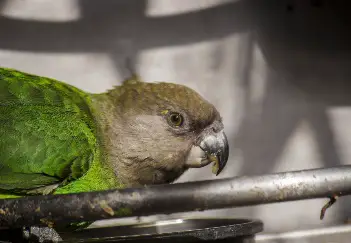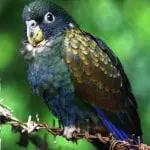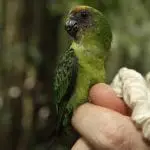Scientific Facts
| Common Name | Brown-headed Parrot |
| Scientific Name | Poicephalus cryptoxanthus |
| Lifespan | 20 – 25 Years |
| Size | 22cm (8.6 inches) |
| Body Mass | 120-156g (4.2 – 5.4 oz) |
| Habitat | Woodland, riparian forests, savanna |
| Distribution | Southeastern Africa |
Information & Physical Appearance
Video URL:
Embed Code: <iframe width=”560″ height=”315″ src=”https://www.youtube.com/embed/YLBZqXK1aUQ” frameborder=”0″ allow=”accelerometer; autoplay; encrypted-media; gyroscope; picture-in-picture” allowfullscreen></iframe>
The Brown-headed Parrot (Poicephalus cryptoxanthus), also known as Concealed-yellow Parrot, belongs to the order Psittaciformes, the family Psittacidae, the tribe Psittacini, and is a south-eastern African parrot.
Based on coloration and size, there are three recognized subspecies, including the nominate race. Nowadays, the existence of the zanzibaricus race is doubted because of the fact that experts did not really find a significant difference in the size between brown-headed parrots inhabiting the mainland, and those occurring in Zanzibar.
1. P.crytoxanthus crytoxanthus – Brown-headed parrot (nominate race).
Both sexes are small-sized birds that do not exhibit sexual dimorphism.
The general plumage of adult males and females is mainly green, with brown coloration on the head. Meanwhile, the neck is grey-brown in color, merging to greenish on the mantle.
The underwings coverts display bright yellow coloration; however, the extent of yellow is variable among individuals. On some specimen, random yellow feathers are easily visible on the wings, neck, and head zone.
The rump, as well as the margins of the feathers found on the underparts, are vividly colored in almost metallic green tones. This particular coloration becomes better pronounced towards the thighs and the vent.
The tail’s edges are olive-brown, tipped green. The iris of the eye is greenish-yellow to yellow. The eye-ring is dark brown/gray in color.
The feet and legs are colored in blackish grey nuances.
The upper mandible displays blue/grey coloration, and the lower mandible is tan. Overall, the bill is dark and appears almost fully black above, gradually merging to whitish below.
2. P. crytoxanthus tanganyikae – Tanzanian brown-headed parrot
Both sexes resemble closely the appearance of the nominate race; however, tanganyikae adults are generally paler than cryptoxanthus species. Also, they are generally less brown and greener.
The major difference that sets apart Tanzanian brown-headed parrots from the nominate race is that tanganyikae species have a greener mantle, and their underparts are brighter.
3. P. cryptoxanthus zanzibaricus – Zanzibar brown-headed parrot
Keeping in mind that the existence of the third subspecies is now doubted, there is no difference in size between brown-headed parrots found in the mainland and those found in Zanzibar.
Juveniles
In the nominate race, as well as in the tanganyikae race alike, juveniles’ plumage is the same as in adults, with the slight difference that it is duller, and the eyes are brown instead of yellow to greenish-yellow.
Also, the immature is described as yellowish below.
Similar species in both shape and color include the Niam Niam Parrot. However, the Niam Niam Parrot is smaller in size than the Brown-headed Parrot. Furthermore, the irises are reddish.
Lifespan
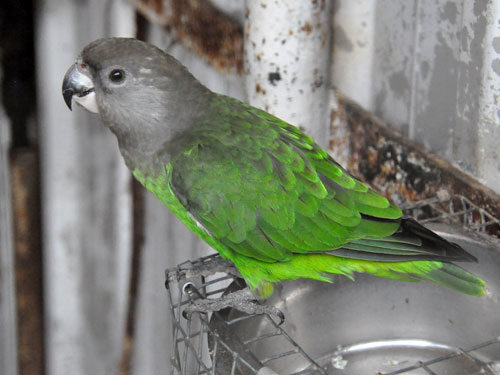
Image Source
On average, the brown-headed parrot is known to live for between 20 – 25 years in captivity with proper care. Some individuals may live up to 30 years of age, yet in most cases, these birds live for roughly 15 – 20 years.
The generation length is estimated at 10 years.
Ecosystem & Habitat
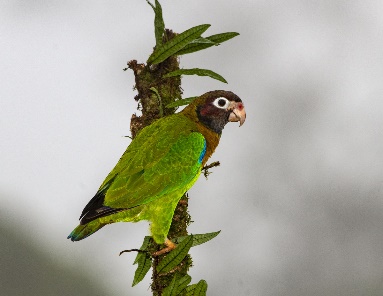
Endemic to Southeastern Africa, the brown-headed parrot has a high affinity for the native baobab trees.
The native range of the nominate race (P.c. cryptoxanthus) extends through eastern Kwazulu, eastern Transvaal and eastern Swaziland, reaching to the north-eastern parts of the Republic of South Africa to south-eastern Zimbabwe and southern Mozambique.
The natural range of P.c. tanganyikae subspecies spans across Mozambique, in particular, north from southern Malawi and Save River, reaching eastern Tanzania (with coastal Kenya, Pemba Islands, and Zanzibar included).
Brown-headed parrots are known to occur in just about any riparian and woodland forest located within the dry woodlands and the forest-savanna. Also, these parrots occur in coconut plantations.
These birds prefer to live at low to mid-elevations and are found below 3936ft. (1200 meters).
Food & Diet
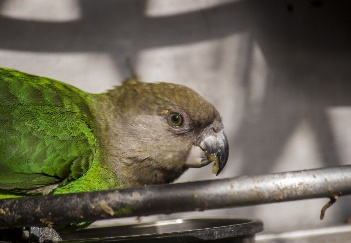
Image Source
The diet of brown-headed parrots in the wild consists of various plant-based foods, such as fruits (including but not limited to berries and figs), flowers (especially coconut palm flowers), seeds (including pods and unripe seeds), and young tree shoots.
More specifically, these birds prefer the flowers and fruits of Acacia spp. and Trichilia emetica (Natal Mahogany Tree).
Aloe vera nectar is also gladly taken. In addition to that, maize and millet from cultivated land are consumed. Brown-headed parrots do eat lepidopteran larvae, as well.
This bird species are seen as opportunistic generalists in regard to their diet in the wild. That’s because their natural diet is known to change depending on the availability or unavailability of suitable food sources in their current environment.
Behavior
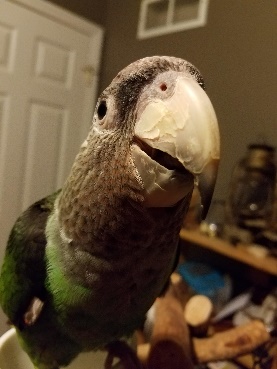
The brown-headed parrot’s call, in particularly, the flight call, is characterized by loud, strident notes. These notes are to rise in pitch with each note that follows. High-pitches staccato notes are also included.
While feeding by slowly foraging for food throughout the day, these parrots are to chatter softly. Around midday, these birds are to drink water.
Brown-headed parrots are gregarious and are known to form flocks that consist of up to 50 birds. When it comes to their nesting behavior, they prefer tree cavities.
The flight pattern is direct and rather fast.
Reproduction
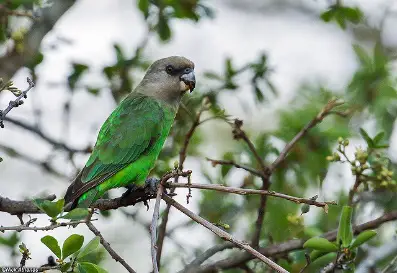
Image Source
Brown-headed parrots reach sexual maturity as soon as they turn about 2 years of age. However, they may not actually breed before they become 3 or 4 years old.
Some pairs are known to breed year-round in South Africa, yet most of the pairs will choose to breed during the winter season.
The clutch consists of 2-4 eggs. The incubation period lasts for about 28 days. It is when young parrots are around 8-10 weeks old that most of them are to wean.
Survival Threats & Conservation
Poicephalus cryptoxanthus is listed as Least Concern on the IUCN Red List of Threatened Species.
Unfortunately, the population trend is estimated to decrease based on the 2018 global assessment.
On the bright side, the species occurs in at least one protected area, and conservations sites are identified over the entire range.
The major survival threat is none other but trapping for wild bird trade on the international level, which is becoming an especially big concern in Mozambique. In other areas, the populations have suffered a decline because of being vulnerable to the ongoing habitat loss.
Brown-headed parrots remain common in areas of South Africa where fruit and grain crops can be exploited.
Availability – Where to Get a Brown-headed Parrot
Despite being continuously trapped for international wild bird trade, brown-headed parrots remain uncommon in captivity when compared with other parrots, such as the yellow-crowned amazon, among others.
However, nowadays, the popularity of brown-headed parrots as pets keeps rising, following in aviculture.
Also, these birds rank among the iconic native birds of the African continent. This is believed to further contribute to brown-headed parrots becoming heavily sought-after exotic birds to keep as pets, especially when keeping in mind their simplistic yet unique, adorable appearance that makes them truly stand apart.
The reasons why many choose to get a brown-headed parrot as a pet is due to these birds’ exceptionally friendly personality, their playful, amusing behavior, as well as their quiet disposition.
One can acquire a brown-headed parrot from a limited number of reputable vendors, both online and offline. As with any other cage birds, potential caregivers want to opt for captive-bred brown-headed parrots.
Although one can get a brown-headed parrot from trust-worthy pet stores and expos, caregivers-to-be are also encouraged to opt for a bird directly from reputable breeders. Make sure to receive a guarantee of the bird’s origin and health status.
Interesting Facts
Video URL
Embed Code: <iframe width=”560″ height=”315″ src=”https://www.youtube.com/embed/9Xj5dGFhAzY” frameborder=”0″ allow=”accelerometer; autoplay; encrypted-media; gyroscope; picture-in-picture” allowfullscreen></iframe>
1. Brown-headed parrots are described as “the greenest” of all parrots found in the sub-region.
2. Keeping in mind that brown-headed parrots’ underwing coverts display bright yellow coloration, it is curious to find out that it is from this yellow coloration that the specific scientific name of the species is derived. “Kryptos” is a word of Greek origin that translates into “concealed” or “hidden,” while “xanthos” means “yellow.”3. Russian President Vladimir Putin is a proud owner of a brown-headed parrot.
4. In some brown-headed parrots, random yellow feathers can be spotted on the neck, head, and wings. The very reason why these unusually colored random feathers occur remains unknown. However, it is suggested that these feathers may be a result of young chicks being over-vigorously preened by their parents.
5.The existence of the third subspecies (P. cryptoxanthus zanzibaricus) is strongly doubted up-to-date, and more specifically, while this subspecies did exist back in time, it is nowadays mostly considered extinct. Currently, experts can find no difference in the size of the once existing zanzibaricus race and the brown-headed parrots occurring in the mainland.
The possible reasons for the extinction of this subspecies are believed to be the direct intervention of humans in terms of trapping the birds, or the interbreeding with the immigrant subspecies from the mainland (P.c. tanganyikae).
How to Care for the Brown-headed Parrot
Video URL:
Embed Code: <iframe width=”560″ height=”315″ src=”https://www.youtube.com/embed/O3vN1YRN5T0″ frameborder=”0″ allow=”accelerometer; autoplay; encrypted-media; gyroscope; picture-in-picture” allowfullscreen></iframe>
1. Housing
Being the active birds that they are, brown-headed parrots should be provided with as large a cage as possible.
The minimum length of an indoor cage is 6ft. (1.8 meters).
Walk-in aviary works best and should measure at least 7ft. (2.1 meters) in length.
Cages in the following dimensions (at a minimum) will work great for housing a brown-headed parrot: 3 ft x 3 ft x 6 ft or 4 ft x 4 ft x 4 ft.
Opt for cages with 3/4″ bar spacing.
Make sure that the cage is equipped with at least two perches, as to allow the parrot/s to move freely between them.
It is highly recommended to provide an outdoor cage/flight cage in addition to an indoor cage so that the parrot pet can enjoy the extended health benefits of fresh air and natural sunlight in good weather.
2. Diet & Feeding
When choosing a good pellet based mix or commercial seed mix, opt for mixes that are made specifically for Poicephalus parrots. This should be the primary source of food, making up for approximately 70% of a healthy, balanced, varied diet.
A good amount of fresh fruits should be also provided, including but not limited to bananas, oranges, and apples.
Occasionally, brown-headed parrots should be also offered vegetables, such as boiled/steamed corn, and healthy cooked pulses and beans.
Dry, sprouted, as well as soaked sunflowers seeds should also be available in the diet.
Rearing food includes hard-boiled eggs, carrots, and wholegrain bread. All of these should be carefully ground to a crumbly consistency.
3. Cage Enrichment & Accessories
Brown-headed parrots should be provided with a wide variety of toys to keep these birds well-entertained at all times, both out and in the cage.
As a rule of thumb, when it comes to mental stimulation and exercise, daily out-of-cage activities should be available.
Apart from providing activities, the type of toys that brown-headed parrots generally enjoy include non-toxic wooden blocks, as well as bird-safe, non-toxic tree branches (fir, willow, pine and/or elder) of various textures and sizes, which cater to these birds’ needs to chew.
Both non-destructible and destructible toys should be provided. Other types of toys for brown-headed parrots include food-finder toys, foot toys, and preening toys.
Nonetheless, hanging perch toys of various sizes and textures should be provided. Vegetable-tanned leather toys and push-and-pull toys are strongly recommended, too.
4. Behavior & Personality
Brown-headed parrots are beloved for their sweet temperament. Being relatively small in size, they also happen to be quieter than other species of parrots, which makes them especially suitable pets for apartment dwellers.
Brown-headed parrots are outgoing, quite affectionate in general, and very energetic. However, they do not really crave for attention in the same way as other parrot species do.
Once they reach maturity (about 2-3 years old), these parrots are known to become more independent.
Mind that during the breeding season, mature males may show aggression.
Brown-headed parrots are fully capable of learning to perform tricks. In the case they are well-socialized, they will also enjoy being handled.
When they switch into a playful mood, they can be exceptionally entertaining!
It is best to socialize young birds from an early age to many people. Also, expose young birds to new experiences in order to keep them away from possibly developing a fear of new situations.
Mind that adult brown-headed parrots are much less adaptable to unfamiliar environments if they haven’t been socialized and exposed to new experiences when still immature.
With a fun and friendly personality, the brown-headed parrot is often quite calm and willing to play by itself, yet it will still greatly depend on social interaction with the owners and/or with other birds, as well as spending time with the caregivers in general.
Favored for their goofy, silly, funny tricks, as well as for their calm, quiet, cuddly moments, brown-headed parrots can make incredible pets that are full of charm for the right owners.
5. Speech & Sounds
The talking ability of brown-headed parrots is considered moderate, with some of these birds being more talented in learning to talk than others.
In general, these parrots are great at mimicking whistles and sounds.
Brown-headed parrots possess an especially desirable trait for many owners-to-be – they are very quiet, unlike other parrot species that are known for being rather loud and noisy!
Ultimately, because of their calm and friendly personality, brown-headed parrots do not have the need to express themselves vocally as much as other parrot species do.
With patience and proper training, over time, these parrots can learn several words and then repeat them in an exceptionally crisp voice.
Most of the sounds these parrots make can be heard as the birds are eating and include happy mumbling and soft chirps, which signify their joy from feeding.
6. Cleaning & Maintenance
To maintain good plumage, and nonetheless, healthy skin condition, bathing, or showering is vital to brown-headed parrots. Also, they can be misted. For these purposes, small bathing dishes or regular water sprays should be offered.
Always allow these parrots time to dry in a warm room or directly in the sun in good weather.
If the wings of the brown-headed parrot are clipped too much, injury can occur, since these birds are heavy-bodied and tend to drop to the floor just like stone, often resulting in broken chest bone.
Don’t forget to keep high hygiene when it comes to cage maintenance, which included thoroughly cleaning the entire arsenal of toys and cage accessories on a regular basis.
7. Common Health Issues
Most species of African parrots, including but not limited to the brown-headed parrot, are highly adaptable, as well as quite hardy birds.
Brown-headed parrots are known to quickly adapt to their new home, as long as the caregiver is to keep the conditions optimal.
The best way to ensure a healthy brown-headed parrot pet includes good hygiene, a balanced diet, and plenty of social interactions. When provided with proper care and lots of love, these small-sized parrots can live for many years without any troubles.
8. Breeding
As a rule of thumb, brown-headed parrots breed successfully in captivity. Depending on locality, the breeding season typically starts in April and continues throughout October, yet some prolific birds may choose to breed year-round.
- Provide a vertical nest box that measures 10 inches x 10 inches x 12 inches. L-shaped nest boxes can also work fine.
- The average clutch size is 2 – 4 eggs. These are shiny and white.
- Incubation takes 22 – 26 days.
- Young chicks tend to be very difficult to hand-rear from the egg. Hatch weight is 0.2oz. (5.5 – 6.0 grams). Also, they need to be fed frequently. It is best that the chicks are to be kept with their parents for about 1 – 2 weeks upon hatching.
- In about 7 to 9 weeks, the young chicks will be ready to fledge.
FAQ Section
How Long Do Brown-headed Parrots Live?
Provided good care is given, brown-headed parrots can live up to 30 years, yet they typically live for about 15 – 20 years on average.
Are Brown-headed Parrots Good Talkers?
The talking ability of the brown-headed parrot is considered moderate. These birds are able to learn to talk but are not as talented on that note as other parrot species, such as the blue-fronted amazon.
How Big Is a Brown-headed Parrot?
Brown-Headed Parrots typically reach about 9 inches in length. These birds weigh around 125 grams and are considered small-sized parrot species.
Do Brown-headed Parrots Make Good Pets?
Brown–headed parrots can make wonderful pets as their personality is similar to most of the members of the Poicephalus family, which are described as social, active, energetic, entertaining pets. However, as compared to other Poicephalus species, brown-headed parrots are known as a bit milder mannered and calmer in general, as well as being able to have fun on their own, apart from enjoying regular interactions with humans.
What Do Brown-headed Parrots Eat?
In the wild, brown-headed parrots are known to eat seeds, fruits, young shoots, and flowers. In captivity, they thrive on a balanced diet consisting primarily of pelleted seed or seed mixes, as well as a good portion of fruits and vegetables.
Are Brown-headed Parrots Noisy?
Brown-headed parrots tend to be quieter birds than other parrot species. Therefore, they are regarded as suitable bird pets for apartment dwellers.
Are Brown-headed Parrots Endangered?
Even though not considered severely endangered with extinction, brown-headed parrots are listed on the IUCN Red List of Threatened Species under the Least Concern category. The ongoing massive population decline is related to habitat fragmentation, habitat destruction, and trapping.

